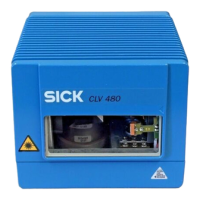Chapter 3 Operating Instructions
CLV 480 Bar Code Scanner
3-2 © SICK AG · Division Auto Ident · Germany · All rights reserved 8 010 080/O824/10-02-2005
Product description
AMS 60-012 (no. 1 017 140) for 115 V AC 50 to 60 Hz/24 V DC,
enclosure rating max. IP 54
AMS 100-011 (no. 6 021 105) for 18 to 30 V DC, enclosure rating max. IP 65
–For connecting two CLVs:
AMV 30-071 (no. 1 017 391) for 18 to 30 V DC, enclosure rating max. IP 54
AMV 200-011 (no. 6 021 106) for 18 to 30 V DC, enclosure rating max. IP 65
– or –
Alternatively, a non-SICK Power pack with a voltage output of 18 to 30 V DC pursuant
to IEC
742 (functional extra-low voltage pursuant to IEC 364-4-41) and a minimum po-
wer output of 20 W.
Cable no. 2 020 264 (3 m (9.84 ft)) with 15-pin D Sub HD connector and one open
end for connecting the CLV to the non-SICK Power pack (supply voltage).
2. The following operating voltages/power output values:
– AMV 60-011: 18 to 30 V DC (pursuant to IEC 364-4-41), min. 20 W
– AMV 30-071: 18 to 30 V DC (pursuant to IEC 364-4-41), min. 40 W
– AMV 100-011: 18 to 30 V DC (pursuant to IEC 364-4-41), min. 20 W
– AMV 200-011: 18 to 30 V DC (pursuant to IEC 364-4-41), min. 40 W
– AMS 60-013: 230 V AC ±10 % 50 Hz
– AMS 60-012: 115 V AC ±10 % 50 to 60 Hz
3. Fitting cables see Chapter 5.2.2 Prefabricated cables (overview), Page 5-2.
4. With external clock pulse (start/stop of reading interval) supply via the "Sensor"
switching input: a suitable reading pulse sensor for signaling an object with a bar code,
e.g. a photoelectric reflex switch.
5. With extended external clock pulse (stop of reading interval) supply via the “IN 4“
switching input: a suitable reading pulse sensor for generating the end of reading
intervall, e.g. a photoelectric reflex switch.
6. With object distance detection via the "IN 0" to "IN 4" switching inputs: suitable sensors
for multi-stage dynamic focus control, e. g. photoelectric reflex switches.
7. To separate bar codes with the same name (same code type, identical data content)
using the "Compare Code Position" function: a suitable incremental
encoder,
e. g. no. 2 022 714.
8. A higher-level computer (host) with a data interface of type RS 422/485 or RS 232.
9. A PC (min. 80486, 66 MHz, 16 MB RAM, CD drive, a serial port (COM x), mouse
(recommended)) with Windows 95
TM
/98
TM
, Windows NT4.0
TM
, Windows 2000
TM
or
Windows XP
TM
.
10. A 3-core RS 232 data cable (null modem cable) with two 9-pin D Sub sockets for con-
necting the PC to the terminal interface of the CLV in the Connection Module, e. g. no.
2 014 054. Pin
2 (RxD) and Pin 3 (TxD) are crossed.
11. An HTML browser, e. g. Internet Explorer
TM
, for using the online help system "CLV-Setup
Help".
12. The appropriate bus connection module BMV/BMH 10 (available on request) for con-
necting the CLV to the Interbus-S, Profibus DP, the Device Net or to Ethernet.
13. For connection of the CLV to the CAN Scanner Network: the Operating Instructions
“Application of the CAN interface“ (no. 8 009 180, English edition).

